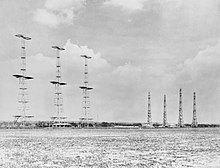Klein Heidelberg
Klein Heidelberg (KH)[2] was a passive radar system deployed by the Germans during World War II.
It used the signals broadcast by the British Chain Home system as its transmitter, and a series of six stations along the western coast of continental Europe as passive receivers.
[5] Chain Home's (CH) large antennas were visible from the French coast, hence the Germans were aware of their precise locations.
[6] Beginning in 1942, Dr. Wächter of Telefunken, working with radio engineers at the Reichspost, used this information to build a passive radar system using the CH broadcasts and their own receivers.
[7][8] This was not unlike the Daventry experiment setup that had first been used to demonstrate the radar concept in the UK in early 1935.
[9] To this basic concept, Wächter added the ability to measure the rough azimuth of the target by turning the entire antenna and looking for the maximum signal.
Another side-effect of the long wavelength was that the angular resolution was relatively low, and although a lobe switching system was considered, it was apparently never used in service.
[10] The signals from both antennas were sent to two CRTs taken from the Würzburg radar, which, in typical German fashion, were used as J-scopes.
Using a hand wheel, the operator adjusted a delay circuit until the main blip of the directly received signal was at the 12 o'clock position on this display.
When plotted, these points form an ellipse with the CH station at one foci and the KH receiver at the other.


